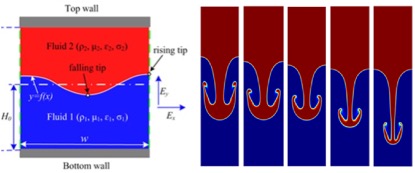Recently,
Dr. Qingzhen Yang from BEBC has published a research paper in International Journal of Heat and Mass
Transfer entitled "Electrohydrodynamic Rayleigh-Taylor instability in
leaky dielectric fluids".
Rayleigh-Taylor
instability (RTI) is a phenomenon that takes place at the interface of two
stratified immiscible fluids when the denser fluid placed over the lighter one
under the action of gravity, where gravity force breaks the equilibrium at the
interface. In this paper, the authors presented an analysis of the influence of
electric field on the Rayleigh-Taylor instability (RTI) of two leaky dielectric
fluids. A numerical model is developed based on the coupled solution of the
governing equations of the electric field (i.e., Poisson equation) and the fluid
flow (i.e., Navier-Stokes equation), where the leaky dielectric model is
employed to take into account the free charges in the fluids. These equations
are formulated within the framework of phase field and solved simultaneously.
The numerical model is applied to study the effect of the electric field on
interfacial morphology associated with the RTI. Various interfacial
morphologies have been observed in the electrohydrodynamic RTI, suggesting that
the electric field has a significant influence on the RTI. An electric field
(horizontal or vertical) may suppress or aggravate the instability depending on
the system parameters the permittivity ratio and the conductivity ratio of the
two leaky dielectric fluids.

Bioinspired
Engineering and Biomechanics Center (BEBC) focuses on how to create proper
microenvironment for cells in vitro.
Hydrogels and other polymers are good candidates for cell culture. Thus we are
interested in the instability phenomena that may occur during polymers
fabrication and this is the motivation of this paper. The authors of this paper
include Dr. Qingzhen Yang from BEBC, Prof. Ben Li from University of
Michigan-Dearborn and also the Chair of BEBC, Prof. Feng Xu. This work is
financially supported by the NSFC (51605377, 11522219, 11372243).
Article
Link: http://www.sciencedirect.com/science/article/pii/S0017931016324620